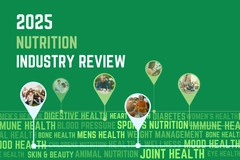
- Industry news
Industry news
- Category news
- Reports
- Key trends
- Multimedia
Multimedia
- Journal
- Events
- Suppliers
Suppliers
- Home
- Industry news
Industry news
- Category news
- Reports
- Key trends
- Multimedia
Multimedia
- Events
- Suppliers
Suppliers
JRS highlights wheat fiber’s nutritional potential for meat alternatives

28 Sep 2020 --- Wheat fiber has nutritional benefits and texture attributes, which can be utilized to help formulate meat alternatives for health conscious consumers, Annegret Stier, regulatory and nutrition expert at J.Rettenmaier & Söhne (JRS), tells NutritionInsight.
Highlighting the company’s Vitacel wheat fiber, Stier says it is a simple food ingredient that is clearly understood by consumers. This is one of its major advantages as it does not cause a negative impact on consumer acceptance by adversely affecting sensory attributes, she adds.
According to Stier, Vitacel can address the rising consumer demand for gut health-boosting formulations. Moreover, its addition to foods can target afflictions such as diabetes and even cater to low-FODMAP diets.
“Vitacel fiber is available in different lengths and functionalities that cover all applications. The fibrous structure is a side effect that you can take advantage of, within the development of meat alternatives, which are currently in great demand.”
 Annegret Stier, regulatory and nutrition expert at JRS.“This way you can mimic meat products more closely. In the development of a plant-based alternative, we can help address the problems related to conventional meat consumption and offer a real solution for consumers who are interested in a healthier and more sustainable lifestyle,” Stier adds.
Annegret Stier, regulatory and nutrition expert at JRS.“This way you can mimic meat products more closely. In the development of a plant-based alternative, we can help address the problems related to conventional meat consumption and offer a real solution for consumers who are interested in a healthier and more sustainable lifestyle,” Stier adds.
Gut health in focus
Two randomized controlled studies have confirmed that Vitacel wheat fiber contributes to gut health by maintaining normal bowel function, and a third study to support this is underway, details Stier.
In the first two studies, the test subjects received a standard diet including processed meat and convenience products enriched with Vitacel wheat fiber.
“This fiber delivers a clear advantage for people suffering from gastrointestinal diseases,” she affirms. Its consumption did not cause side effects like bloating or constipation; thus enabling a diet high in fiber but low in FODMAP.
The in vitro study also verified the fermentative potential of JRS’s wheat fiber. “However, the insoluble nature combined with a high degree of polymerization creates a slower fermentation compared to highly and fully fermentable soluble fiber.”
“This aspect is of great importance in regards to the advancing field of gut microbiota science. Vitacel wheat fiber can positively influence the gut microbiota and thereby counteract several non-communicable diseases like diabetes,” Stier underscores.
Effects on metabolism
For several years, the German Institute of Human Nutrition Potsdam-Rehbruecke (DIfE) has extensively been investigating the effect of Vitacel wheat fiber on human metabolism. Through this work, formulators can convincingly demonstrate the anti-diabetic effect of insoluble dietary fiber, Stier explains.
“Currently, consumers are becoming more aware of the relationship between nutrition, the gut microbiota and health, which increases the potential of our fiber ingredient in helping to close the world population’s fiber gap,” she highlights.
Closing the fiber gap to boost health has long been an issue the industry is trying to address, as consumers become more savvy of fibers’ importance.
Consuming an adequate amount of fiber plays a crucial role in a wide range of health-related issues, by helping to reduce obesity, improve cholesterol and glycemic index levels and contribute to weight management.
According to Innova Market Insights, there has been a steady rise in fiber-related claims, with 9 percent average annual growth in F&B launches from 2015 and 2019. The top category is cereals, with 20 percent of launches in 2019 featuring a fiber-related claim.
 The production of Vitacel wheat fiber further demonstrates how JRS follows its green philosophy. Bakery follows closely behind at 19 percent, with snacks (13 percent) and ready meals and side dishes (10 percent) trailing behind. Notably, sports nutrition is the fastest growing category featuring fiber-related growth, with a 39 percent CAGR (Global, 2015 to 2019).
The production of Vitacel wheat fiber further demonstrates how JRS follows its green philosophy. Bakery follows closely behind at 19 percent, with snacks (13 percent) and ready meals and side dishes (10 percent) trailing behind. Notably, sports nutrition is the fastest growing category featuring fiber-related growth, with a 39 percent CAGR (Global, 2015 to 2019).
Addressing sustainability
As the world population grows, resources are becoming increasingly scarce and their careful handling increasingly important, according to Stier.
“In this regard, the production of Vitacel wheat fiber is a good example as it further demonstrates how JRS follows its green philosophy. For the production of Vitacel wheat fiber, byproducts of the food and agriculture industry coming from solely one region are used.”
“Thanks to extensive process knowhow, the JRS company is able to purify and functionalize those valuable plant-based materials and thereby fully exhaust their potential. Additionally it is a waste-free production process within a closed production cycle for example by reusing the process water. Even the energy that is required can largely be recovered from this cycle,” she details.
The resulting Vitacel dietary fiber is mainly used for food product improvement by fiber enrichment and nutrient replacement. According to the Organisation for Economic Co-operation and Development (OECD), a healthy diet is fundamental to maintain the performance of the population, which is an important aspect in terms of social and economic sustainability.
“With Vitacel, JRS Food Ingredients helps to safeguard the environment as well as human health and contributes comprehensively to sustainability from farm to fork,” Stier concludes.
Previously, NutritionInsight reported on the latest fiber trends and how COVID-19 has put wellness top of mind for consumers.
By Kristiana Lalou











